Friday, April 25, 2008
Berlin, Germany, 11-15 Oct 2006: Pergamon Museum
Processional Way & Ishtar Gate
Labels: antiquity, architecture, art, Berlin, Germany
Wednesday, March 12, 2008
Kuala Lumpur, Malaysia, 7-9 Mar 2008: Petronas Twin Towers
Dare To Dream
| In KL over the weekend of the Malaysian General Elections on 8th March. It is an unusually quiet and tense Saturday night. The ruling party BN goes on to lose 5 states, their heaviest loss in nearly 4 decades. A resounding nay to racial politics. Oblivious to the burgeoning tumult, we dine at the kitschy Saloma Bistro, Jalan Ampang, near the Petronas Towers. Stolidly statuesque in the daytime, the twin towers - joined by a skybridge - acquire a steely opalescence when lit at night. Almost too beautiful. Gazing at the towers, time stands still. Notwithstanding their controversial birth, these grand dames have become transfigured as iconic symbols of the capital. Perennial beacons. Solemn witnesses to the winds of change sweeping the peninsula. |
Labels: architecture, Kuala Lumpur, Malaysia
Monday, March 10, 2008
Beijing, China, 2 Mar 2008: The Great Wall DIY
To Badaling By Public Bus
I was determined to visit the Great Wall on this, my third business trip to Beijing. Discouraged by horror tales of tours with time-wasting (and expensive) shopping stops, Joey and I decided (or rather I decided and Joey, suffering an impending flu attack and bravely battling the cold weather, reluctantly followed) to take the public bus to Badaling. It is possible, and in fact rather easy, to do-it-yourself. Here's how: 1. Take the subway to the Line 2 stop, Jishuitan (2RMB). Get out via exit B. 2. Either walk about 10 minutes to Deshengmen (you should be able to see this large fortified ancient gate structure, much like the Qianmen, in the distance) or take a short 3-minute 10RMB taxi ride (inform the driver you are going to Badaling). Ignore the modern bus terminus building along the way. 3. Join the queue for the large green and white long-distance 919 public bus. Check with the driver or conductor that the bus goes to Badaling (if necessary, print out the Chinese script 八达岭). Some 919 buses go only to Yanqing - a town just short of Badaling (why the bus company does not use another number is unfathomable). To add to the confusion, there are other city 919 buses that do not go to Badaling - these start from the afore-mentioned bus terminus. Ignore these. 4. There are express and regular 919 buses to Badaling. The former does not stop along the way, takes less than an hour for the journey, and are all scheduled to depart Deshengmen station before 1130h. The latter takes about 1.5 hours, making several stops along the way, but runs throughout the day. The fare should cost 12RMB on either bus. 5. The buses may depart from the bus bay behind Deshengmen, or from one across the road. Go up the bus to ask the driver or conductor. Do not worry if you miss the bus. There should be 2 or 3 departures every hour. 6. DO NOT BELIEVE ANYONE who tells you there are no more buses to Badaling. They are private bus or taxi touts who want to part you with your RMB. These cheats quote exorbitant fares (e.g. 80 RMB return on a bus). Sometimes, instead of Badaling, you may be brought to Juyongguan, a small Disney castle-like section of the Great Wall between Yanqing and Badaling, without the grand sweeping vista of the latter). Worse, the driver may demand more fare midway through the journey. DO NOT BELIEVE the officials at the information counter also (I suspect they are in on the conspiracy with the touts). BELIEVE ONLY the bus driver and/or conductor on the bus. 7. Be prepared for very crowded buses. It should not be a problem getting seats from Deshengmen, but the bus will be VERY packed on the return trip (at least until Yanqing) as the bus will have picked up passengers from stops farther than Badaling. 8. The last bus leaves Badaling station for Beijing at 1730h. Allow 2 to 3 hours for the Great Wall, and try to avoid rushing for the last bus. (I left Deshengmen at 1300h and returned by 1900h.) Again, DO NOT BELIEVE ANYONE who tells you there are no more buses back. The entrance fee for the Badaling Great Wall is 40RMB. It takes 2 to 3 hours to scale and descend from Haohancheng, the peak of the North Wall (880m above sea level, the 8th of 12 tower stations along this stretch). The South Wall is shorter but steeper in parts, and therefore less popular. While the Badaling Great Wall has been extensively reconstructed (unlike the raw wilderness at sections of the Great Wall at Simatai and Mutianyu), the grand expanse of the wall snaking up and down the surrounding rolling hills is nevertheless breathtaking. The ascent (and descent) requires considerable stamina. If fitness is an issue or time is limited, consider taking the cable car ride (40RMB singe or 60RMB return, last ride at 1600h) to the peak at the 8th station of the North Wall. The cable car entrance is different from the Great Wall entrance (about 1000m apart) - just follow the signs. There are more subway lines being built. By the Summer Olympic Games 2008, there should be a subway stop at the Badaling Express Bus Station (as well as another stop at the Summer Palace). Hopefully, the journey to Badaling will be less traumatic - if only they can clamp down on the scams. |
Labels: antiquity, architecture, Beijing, China, nature, transport, trekking
Saturday, November 03, 2007
Berlin, Germany, 11-15 Oct 2006: Neighbourhoods & Buildings
Neoclassic East & Postmodern West
Berlin sprawls: a giant city of several distinct boroughs. Since the fall of the Wall, the city centre moved to the historic heart of the German capital, Mitte. Former decaying eastern Unter den Linden, the main thoroughfare of former East Berlin, runs westward from Alexanderplatz (with Swedish-made Cold War icon, Fernsehturm or TV Tower) to Brandenburg Tor. Museumsinsel (Museum Island) is the crown jewel of this tree-lined avenue, containing within the compact Spree Island, the exuberantly baroque Berliner Dom (fronting the Lustgarten) and five world-class museums, including Altes Museum (which houses the Egyptian Museum) and the august Ziggurat-inspired Pergamon Museum. The famous quadriga-topped Brandenburg Tor on Pariserplatz marks the margin of the former Berlin Wall. During the Cold War, West Berlin underground trains run through heavily-guarded Geisterbahnhöfe, The green expanse of Tiergarten stretches to the west of Brandenburg Tor. The Berlin Philharmonic and several museums (e.g. Gemäldegalerie) comprising the Kulturforum, are sited here. Imposing silhuoettes of modern edifices and skyscrapers at Potsdamer Platz create a stark juxtaposition to the adjacent horizontal spread of Mitte architecture. Sited in the former West Berlin, the Kaiser Wilhelm Gedächtniskirche (Emperor William Memorial Church) in Kurfürstendamm and Libeskind-designed Jewish Museum are poignant sobre reminders of the city's war past and the Jewish Holocaust. |
Labels: architecture, Berlin, Germany, museum
Saturday, April 07, 2007
Barcelona, Spain, 31 Aug - 7 Sep 2006: La Sagrada Familia
Gaudi Gothic
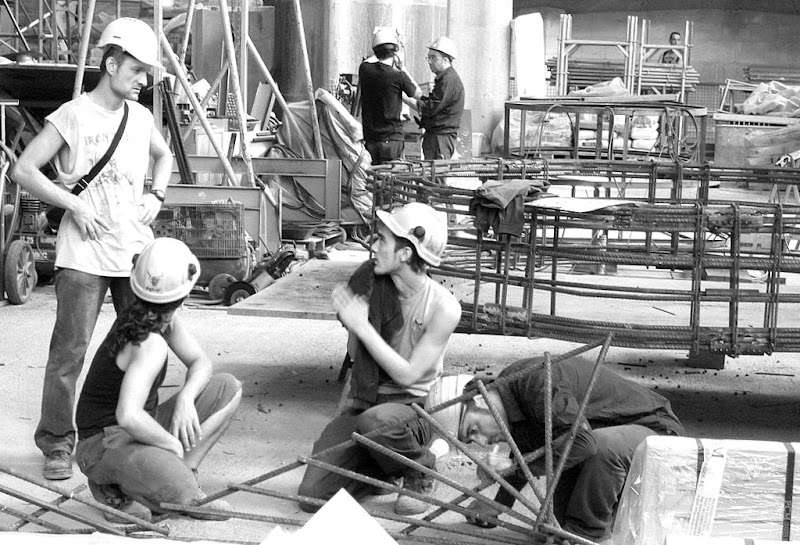  |
| Antonio Gaudi dedicated the last years of his life to building La Sagrada Familia, his towering vision of the Holy Family and the Apostles in concrete. Eighty years after his death, Gaudi's masterpiece is still very much a work in progress. Construction of the central nave continues apace -the finished nave but a model in the underground Gaudi Museum - as awed visitors tread the grounds of the Church, solemnly tracing the Modernista pilgrim trail. |
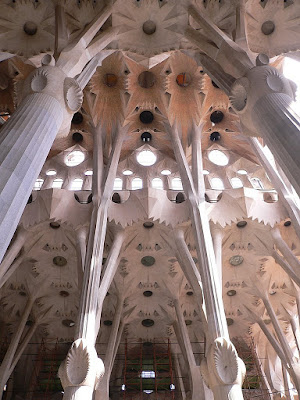  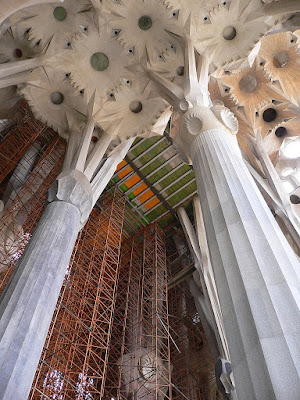 |
| The Nativity Facade is a signature Gaudi original. Hate it ("wedding-cake-in-the-rain") or love it, the facade overwhelms with its grand scale and undulating surfaces dripping with foliate ornaments and myriad details - Gaudi's evocation of the rococco. |
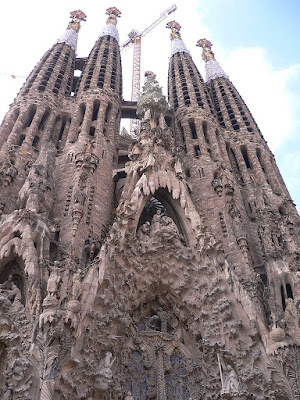  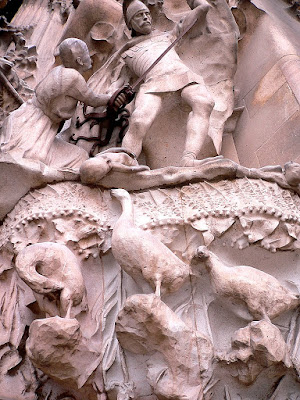 |
| In contrast, the modern Passion Facade is angular and spare, but nevertheless powerful. The Glory Facade, soon to be finished, will add to the apparent disparateness of the Church, yet strangely augmenting the whole. |
 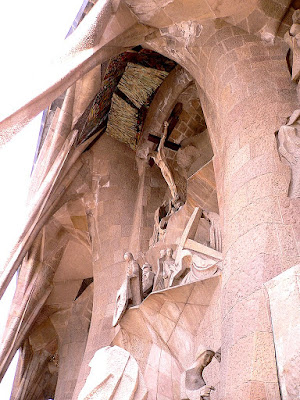 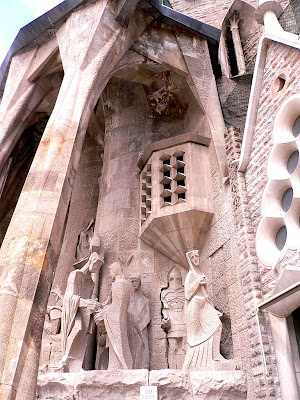 |
| Unifying the different styles are the models on which Gaudi based his designs. Using curves, arches and hyperboloids, he conceived a new universe of pure geometric building forms - transcendent gaudiness that underscores the architectural genius and legacy of the man. |
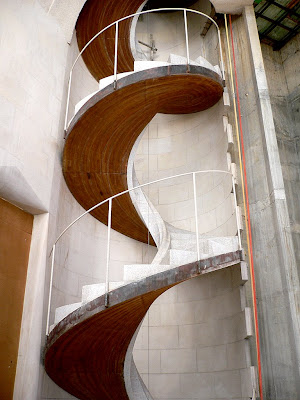 |
Labels: architecture, art, Barcelona, museum, religious site, Spain
Sunday, March 25, 2007
Seville, Spain, 23 Feb 2007: Real Alcazar y Catedral
Mudejar Palace And Gothic Church
  |
| The Christian monarchs Alfonso X and Pedro I (the Cruel) employed Moorish artisans to build the Real Alcazar in the 14th century. The latter allegedly abandoned his wife, preferring to cavort with his favourite mistress in his new pleasure palace. The Alcazar houses fantasy courtyards like the Patio de las Doncellas and delightful gardens that combine a curious blend of Moorish and European influences. It remains the most complete and well-preserved specimen of Mudejar architecture in Spain. |
  |
| Seville Cathedral is the world's third largest cathedral (after Vatican's St Peter's and London's St Paul's) and largest Gothic cathedral. Built on the site on a former mosque, only the minaret - refashioned as a bell tower La Giralda - and the orangery at the entrance remain. Climb up a seemingly endless series of ramps (designed to allow passage of sentries on horseback) to get to the top of the Giralda. From there, enjoy panaromic views of the massive naves of the Cathedral, the nearby Real Alcazar and the traditional dwellings of barrio Santa Cruz. |
     |
Labels: architecture, museum, palace, religious site, Seville, Spain
Cordoba, Spain, 22-23 Feb 2007: La Mezquita y la Sinagoga
Moslem Marvel And Jewish Jewel
  |
| While the rest of Europe was still mired in the Dark Ages, Cordoba was a medieval centre of religious learning and splendid cultural flowering. Under her tolerant Moslem rulers, Cordoba's Christians and Jews enjoyed relative religious freedom. Some, like Maimonides, even achieved prominence. Art, science, mathematics, medicine, philosophy fluorished. La Mezquita is the epitome of mosque architecture. A forest of over 800 marble pillars - salvaged from Roman and other ruins - support airy delicate double horseshoe arches that are decorated with alternating red and white stripes. An optical illusion multiplied several hundred times, the effect is mesmerizing. After Christian conquest, the Holy Roman Emperor, Charles V (yes, him again), commissioned the erection of a cathedral in the middle of the Mosque, against the wishes of the Christian city council. Doubly disappointed and dismayed by the meretricious result, he lived to regret his decision. |
  |
| At the south wall of the Mezquita is the mihrab - a niche that symbolizes the gateway to Mecca. Unusually, this mihrab is not exactly aligned to Mecca, being oriented to the south instead of southeast. The mihrab and the dome above are beautifully decorated with gold mosaic tiles and lovely calligraphy. At her zenith, thousands of Moslem faithful would gather in the Mezquita for prayers. All faced the mihrab, rising and prostrating in unison to the exaltations of Quranic verses that reverberated solemnly throughout the vast grand space. Nowadays, Moslem worship is expressedly proscribed by Cordoba's Catholic bishop. |
  |
| The Synagogue is one of three to survive the Spanish Inquisition. It is located in the heart of Cordoba's Juderia (Jewish Quarters)- a claustrophic labyrinth of narrow alleys and cul de sacs - a short walk from the Mezquita. Easily missed, its humble entrance is nearby a statue of Maimonides. The synagogue consists of a small square room with an upper level for women. On the walls are remains of ornate carvings of geometrical patterns and ribbons of exquisite arabesque calligraphy - surprisingly revealed to be Old Testament Hebrew verses. |
Labels: architecture, art, Cordoba, museum, religious site, Spain
Granada, Spain, 21-22 Feb 2007: Alhambra Grounds
Generalife, Palacio de Carlos V And Alcazaba
   |
| The Generalife at the northeastern tip of the Alhambra was the private pleasure garden of the Sultan. The peaceful quiet of the Water Garden is broken only by tinkling sounds emanating from the fountains. From the Generalife, cross the cypress-lined bridge walkway straddling the Rio Darro to get to the rest of the Alhambra grounds. |
   |
| After conquering the Moors, the Spanish Christian Monarchs continued to reside in the Alhambra. King Charles V commissioned the building of a Renaissance Palace next to the Nasrid Palaces. The exterior is a monumental square edifice, while the interior comprises a round open court surrounded by double rows of classical Ionic atop Doric columns. |
   |
| The Puerto del Vino divides the municipal and military compartments in the Alhambra. From under the gate's arched entrance, the Alcazaba stretches out to the southwestern limits of the palace, framed by the distant Sierra Nevada. Mighty towers loom over the city of Granada at the fortress' feet, vigilantly guarding the isolated Sultan against his populace. |
Labels: architecture, art, Granada, palace, religious site, Spain
Granada, Spain, 21-22 Feb 2007: Alhambra, Palacios Nazaries
The Mexuar, Comares And Leones Palaces
   |
| The Moorish Nasrid Palaces are the Alhambra's jewels. The complex consists of three interconnecting palace groups - the Mexuar Palace, the Comares Palace and the Leones Palace - and the Lindaraja Gardens. Elegant uncluttered lines and spacious courtyards harmonize with ingenious use of water landscape to create an oasis of unrivalled beauty. Due to Islam's prohibition against the use of imagery, the walls and ceilings of the palaces are replete with intricate geometrical designs and religious calligraphic art. They permeate the buildings - integral to the whole, never overwrought - subtly transforming with every shifting light throughout the day. The artisans used plaster almost exclusively for decorative stucco work and were experts in delicate alicatado mosaic tiling. They seemed to be cognizant of the impermanence of the worldly Earth, reveling in the ethereal frailty of their creations. |
 |
| The Courtyard of the Mexuar leads from the Hall of the Mexuar to the Comares Palace. At the adjoining Golden Chamber, visitors waited to be admitted to the Nasrid Sultan's presence. On the southern side of the courtyard is an impressive facade of foliate stucco work that becomes increasingly intricate as the eye scales the wall. |
  |
| The Comares Palace is the nucleus of the Nasrid Palaces. Simplicity of line and balanced proportions lend a serene majesty to the Courtyard of the Myrtles. The Comares Tower appears to magically float on the reflecting pool. Pluck a few leaves from the myrtle shrubs and rub them between the fingers - they emit a most wonderful and refreshing scent. |
  |
| Leave the Courtyard of the Myrtles, and enter the Hall of the Boat. Observe the play of reflected light on the jambs at the entrance. Enter the Hall of the Ambassadors or Throne Room - the palaces' most sumptuously decorated room. Imagine the effect the Sultan had on his minions as he loomed half hidden in the shadowy central alcove at the far wall, silhouetted against the dappled light that filtered in through the filigree stained glass wall. |
  |
| The Leones Palace was the Sultan's private dwellings. The central Courtyard of the Lions is surrounded by myriad slender columns - perhaps reminiscent of the palm trees in a desert oasis in the Sultan's longed-after homeland. The fountain with twelve lion statues, spouting water from their mouths, has been temporarily dismantled for conservation work. |
   |
| The Hall of the Abencerrages and the Hall of the Two Sisters face each other on opposite ends of the courtyard. Both boast magnificent honeycombed plaster mocarabes ceilings. Legend has it that the former was believed to be the site of the infamous slaugther of the Abencerrages clan for one male member's alleged affair with the Sultana. The Hall of the Two Sisters, named for two large flawless slabs of Macael marble at the centre of the floor, leads into the Mirador of Lindaraja. The mirador's beautiful mullion window in the north wall overlooks the Lindaraja Garden, with trickling fountains set amidst fragrant orange trees. |
   |
Labels: architecture, art, Granada, palace, sculpture, Spain

Licensed under Creative Commons Attribution-NonCommercial-NoDerivs 2.5 License

These are the 30 countries that I have ever set foot on. Airport stopovers don't count!
